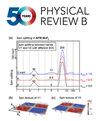分数量子霍尔流体中的量子几何涨落
IF 3.7
2区 物理与天体物理
Q1 Physics and Astronomy
引用次数: 0
摘要
我们在这里提出了一个全面的微观理论,在分数量子霍尔流体中性激发的家族,涉及到量子霍尔基态的几何波动。这种几何模态的许多物理性质可以用解析方法推断出来。其中包括这些几何模式的手性、多样性和能量,以及不可压缩和可压缩流体基态的密度调制关系,无论是否具有平移对称性(例如气泡和条纹相位)。以最近实验测量到的重子模为例,阐明了几何模的普适性和依赖于微观哈密顿量的非普适性。微观理论解释了有效场论和复合费米子理论中的一些现象学成分。它预测了两种手性的几何模式或引力子模式如何在不同能量尺度下的任何拓扑相或可压缩相的实验中被测量。特别是,我们表明,即使对于可压缩的FQH相位,也可以存在间隙几何模式,尽管基态的平移对称性对于这种模式在长波长极限下与外部探针(例如拉曼散射)耦合是重要的。本文章由计算机程序翻译,如有差异,请以英文原文为准。
Quantum geometric fluctuations in fractional quantum Hall fluids
We present here a comprehensive microscopic theory of a family of neutral excitations in the fractional quantum Hall fluids, related to the geometric fluctuations of the quantum Hall ground states. Many of the physical properties of such geometric modes can be inferred analytically. These include the chirality, multiplicity, and energy of these geometric modes, as well as the relationship to the density modulation of the ground states of both incompressible and compressible fluids, with or without translational symmetry (e.g., the bubble and stripe phases). With a particular focus on the recently experimentally measured graviton modes as the special case, we elucidate both the universal aspects of the geometric modes and the nonuniversal aspects dependent on the details of the microscopic Hamiltonians. The microscopic theory explains some of the phenomenological components in the effective field theory and composite fermion theory. It predicts how geometric or graviton modes of both chiralities can be measured in experiments for any topological or compressible phases at different energy scales. In particular, we show that gapped geometric modes can exist even for compressible FQH phases, though translational symmetry of the ground state is important for such modes to couple to external probes (e.g., Raman scattering) in the long-wavelength limit.
求助全文
通过发布文献求助,成功后即可免费获取论文全文。
去求助
来源期刊

Physical Review B
物理-物理:凝聚态物理
CiteScore
6.70
自引率
32.40%
发文量
0
审稿时长
3.0 months
期刊介绍:
Physical Review B (PRB) is the world’s largest dedicated physics journal, publishing approximately 100 new, high-quality papers each week. The most highly cited journal in condensed matter physics, PRB provides outstanding depth and breadth of coverage, combined with unrivaled context and background for ongoing research by scientists worldwide.
PRB covers the full range of condensed matter, materials physics, and related subfields, including:
-Structure and phase transitions
-Ferroelectrics and multiferroics
-Disordered systems and alloys
-Magnetism
-Superconductivity
-Electronic structure, photonics, and metamaterials
-Semiconductors and mesoscopic systems
-Surfaces, nanoscience, and two-dimensional materials
-Topological states of matter
 求助内容:
求助内容: 应助结果提醒方式:
应助结果提醒方式:


